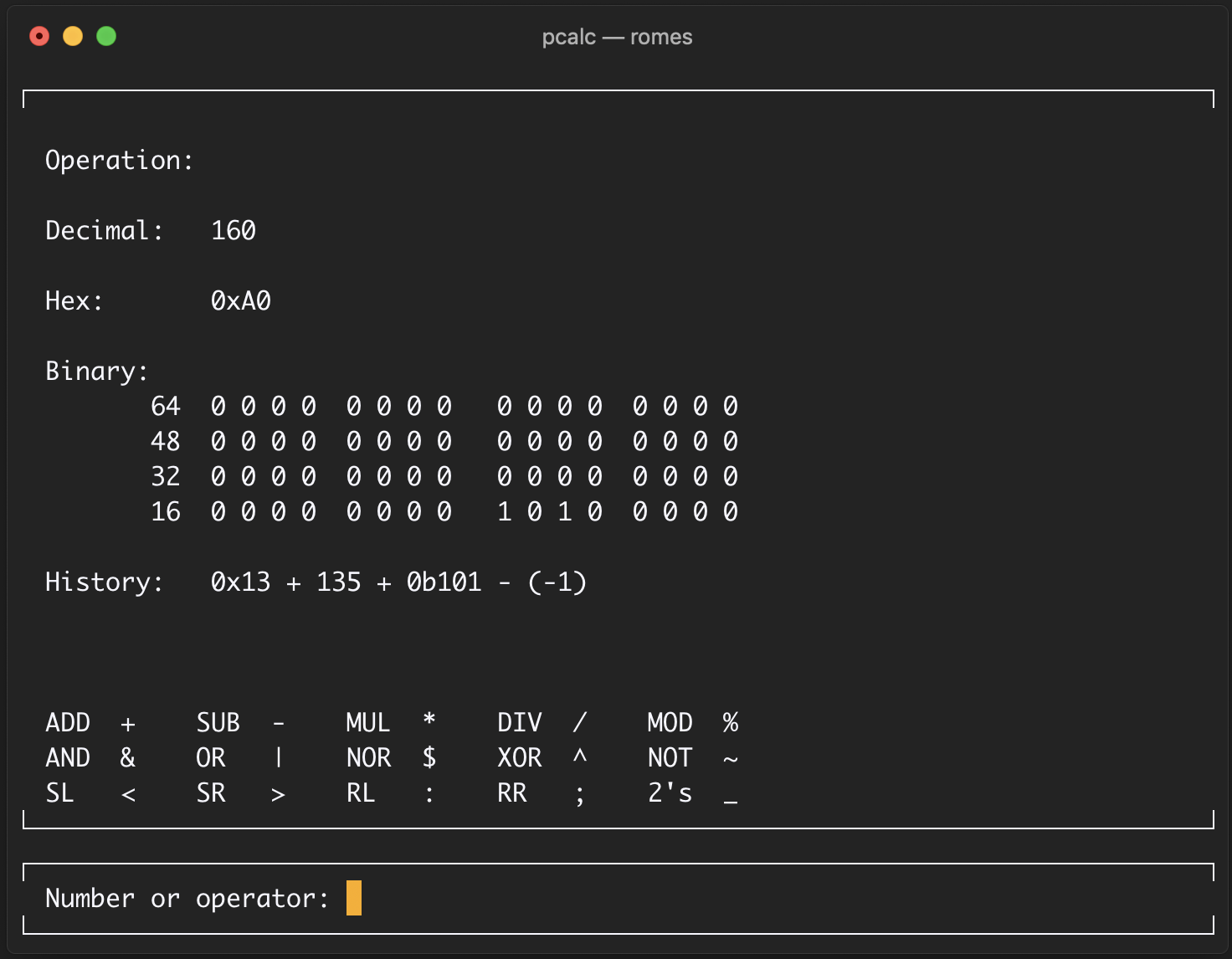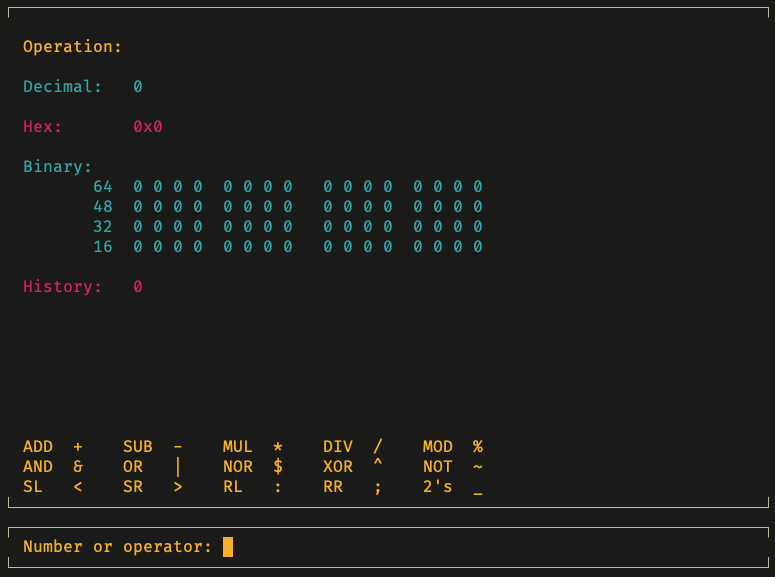The programmer calculator is a simple terminal tool designed to give maximum efficiency and flexibility to the programmer working with:
- binary, hexadecimal and decimal representations at the same time
- bitwise operations
- various operand sizes (16bits, 32bits, 8bits, etc)
and who likes:
- a clear, simple and customizable interface
- open source software
- terminal/cli tools
 The above picture depicts
The above picture depicts pcalc without colors, and below is an example of pcalc with colors enabled (--colors) (which change depending on the terminal profile colors)

The idea was born while developing a Nintendo Gameboy Emulator. Romes - the pitcher - found that the tools given online were clunky and did not allow for "nice multitasking"
With the constant need to visualize and manipulate bits, it became evident that a better solution had to come to life
Install from the homebrew official packages
brew install pcalc
Install from AUR
yay -S programmer-calculator
To build from source you need gcc, ncurses, and the source files.
If you don't have ncurses, please install it (i.e. with your system's package manager) first.
(To install ncurses in Debian based distros run sudo apt-get install libncurses5-dev libncursesw5-dev)
First, clone the repository and change directory to it
git clone https://github.com/alt-romes/programmer-calculator ; cd programmer-calculator
Then, compile the code into an executable file and install it (installs in /usr/local/bin)
sudo make install
Conversely, if you ever want to uninstall, you can run:
sudo make uninstall
Either re-build from source, or, using brew do
brew update
followed by
brew upgrade pcalc
Just run the programmer calculator program
pcalc
There are various ways to insert values/operators, see the example 2 + 2 below:
2, followed by+, followed by22, followed by+22+, followed by22+2(or i.e.2 + 2)
Operator precedence and parenthesis for grouping is used.
2+2*3 evaluates to 8 and (2+2)*3 evaluates to 12
All three number representations are available at the same time, you can insert 0xff + 0b101101 - 5 directly onto the calculator
By default, 64 bits are used for arithmetic, however, when working with bits, quite often we want to work with less. With this calculator you can change the amount of bits used. the number displayed will be unsigned
To use 16 bits instead, type 16bit (bits will also work)
To use 8 bits, type 8bit
To use 0 < n <= 64 bits, type nbit
While running the calculator, you can type what you see for it to appear/disappear:
history to toggle the history
decimal to toggle the decimal representation
binary to toggle the binary representation
hex to toggle the hexadecimal representation
operation to toggle the operation display
Additionally, the interface colors can be toggled on and off.
To set a default interface, define an alias for the program with the desired hidden options
alias pcalc='pcalc -ibxdosn'
i: history, b: binary, x: hex, d: decimal, o: operation, s: symbols, n: no colors
You can also use the long options to hide parts: --history, --decimal, etc.
ADD + SUB - MUL * DIV /
MOD % AND & OR | NOR $
XOR ^ NOT ~ SL < SR >
RL : RR ; 2's _ SE @
- ADD:
a + barithmetic addition - SUB:
a - barithmetic subtraction - MUL:
a * barithmetic multiplication - DIV:
a / barithmetic integer division - MOD:
a % bmodulus from the division - AND:
a & bbit-wise AND operation - OR :
a | bbit-wise OR operation - NOR:
a $ bbit-wise NOR operation : opposite of OR - XOR:
a ^ bbit-wise XOR operation : exclusive OR - NOT:
~abit-wise NOT operation : change all bits of a, 0's into 1's and 1's into 0's - SL :
a < bbit-wise SHIFT-LEFT operation : shift a left b number of times - SR :
a > bbit-wise SHIFT-RIGHT operation : shift a right b number of times - RL :
a : bbit-wise ROTATE-LEFT operation : rotate a left b number of times - RR :
a ; bbit-wise ROTATE-RIGHT operation : rotate a right b number of times - 2's:
_a2's complement operation : 2's complement of a (usually is the symmetric of a) - SE :
@aswap endianness : swap the byte order of a (uses the number of bits set bybitto determine the amount of bits swapped)
Please reference Contributing
